India is a really fantastic place to visit. It is a nation with a rich and diverse history and culture. The most well-known and well-liked trip in the nation, the Golden Triangle trip, offers a fantastic, life-changing introduction to India. Three of India's most respected cities - Delhi, Agra and Jaipur - form the Golden Triangle. The triangle formed by these three cities is roughly 200–250 kilometers long on each side.India's capital, Delhi, is a vibrant blend of modernism and ancient imperial grandeur.
The Red Fort, the Qutub Minar, and the India Gate are among of its intriguing historical landmarks. You can explore temples and contemporary gardens at the same time. You can shop in Delhi's enormous air-conditioned malls or in the busy street markets and bazaars. The Taj Mahal, the pinnacle of Indian architecture, is situated in the city of Agra, which carries on the Golden Triangle's historical, cultural and architectural significance.
Constructed in the 1600s on the Yamuna River's right bank, this stunning white marble tomb symbolizes unending love. The capital and largest city of the Indian state of Rajasthan, Jaipur, is the third city on the Golden Triangle Tour. This pink city is home to numerous exquisite palaces, forts and structures that are deserving of being named a UNESCO World Heritage Site.
You have a once-in-a-lifetime chance to experience the luxury of the Mughals and Maharajas while taking in Indian culture, history and food in these three cities. A minimum of three days or a maximum of eight to ten days can be spent on the Golden Triangle tour, depending on your interests and available time. For at least two more days, one can also include a visit to Ranthambore National Park, which is well-known for the Royal Bengal Tiger. Alternatively, one can extend their vacation to include additional Rajasthani cities like Jodhpur, Jaisalmer and Udaipur, Ranthambore or Kerala or Varanasi.
Delhi, the capital of India, is a city of contrasts. From modern skyscrapers and bustling bazaars to ancient Mughal and British architecture, Delhi offers a unique blend of the old and the new.
Red Fort :
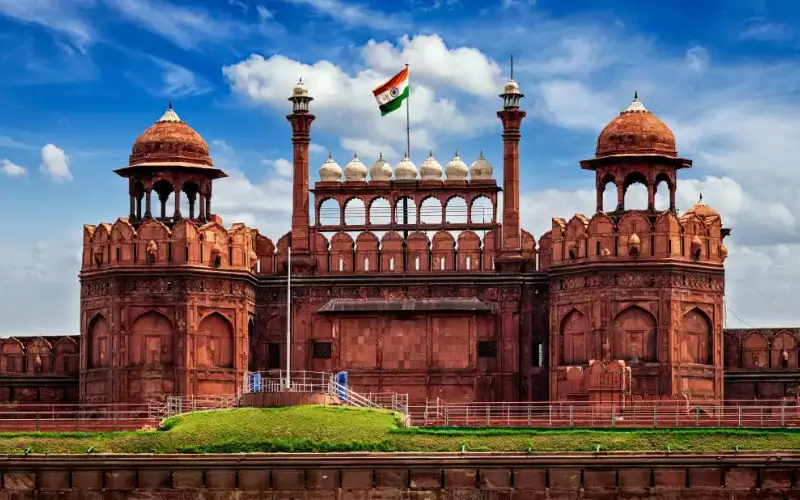
Lal Qila, a UNESCO World Heritage Site, is a magnificent symbol of Mughal power and grandeur in the heart of Delhi. Built by Emperor Shah Jahan in the mid-17th century, the fort was the main residence of the Mughal emperors for nearly 200 years. The imposing structure of red sandstone walls extending over a perimeter of 2.5 kilometers evokes a sense of awe. Within the fort, visitors can visit the beautiful gardens as well as the Diwan-i-Aam (Hall of Public Audience), Diwan-i-Khas (Hall of Private Audience), and the Mumtaz Mahal. The fort's sound and light show in the evening narrates the fascinating history of the Mughal Empire.
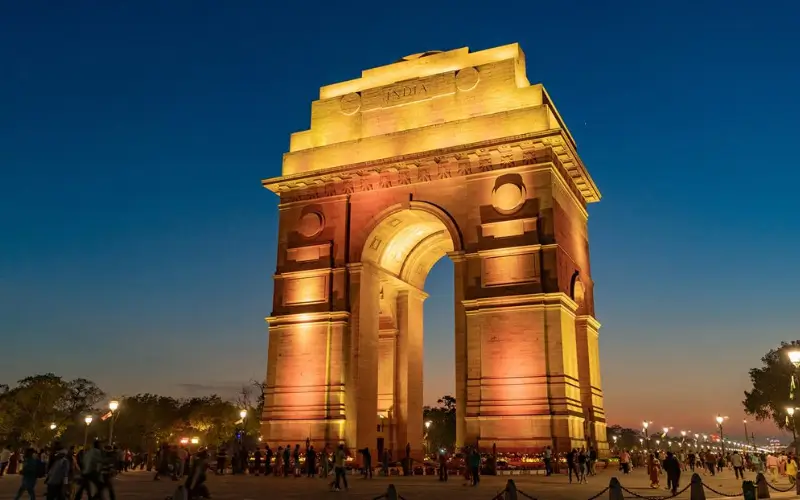
An iconic landmark in Delhi, India Gate is a national monument dedicated to the soldiers of the British Indian Army who lost their lives during World War I. Designed by Sir Edwin Lutyens, this 42-meter-high war memorial is made of sandstone and houses a distinctive Amar Jawan Jyoti, which honors the unknown soldiers. India Gate is surrounded by lush green lawns and is a popular spot for locals and tourists to relax, picnic and enjoy the cool evening breeze. It also has special significance, especially during Republic Day celebrations when the Indian President and military leaders gather for a grand parade.
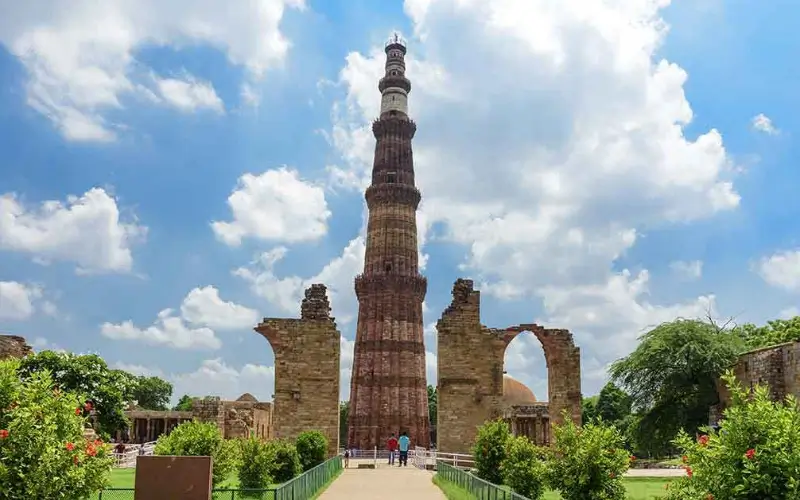
Oldest and tallest minarets in India. At a height of 73 meters (240 feet), this UNESCO World Heritage Site is a testament to the architectural brilliance of the Delhi Sultanate era. Built in 1193 by Qutb-ud-Din Aibak, the minaret is made of red sandstone and is adorned with intricate carvings and inscriptions. It was originally constructed as a tower for the muezzin to call people to prayer and is one of the best examples of Indo-Islamic Afghan architecture. The surrounding complex includes the Quwwat-ul-Islam Mosque and the Iron Pillar, which dates back to the 4th century and has remained rust-free for over 1,600 years, adding to the historical intrigue of the site.
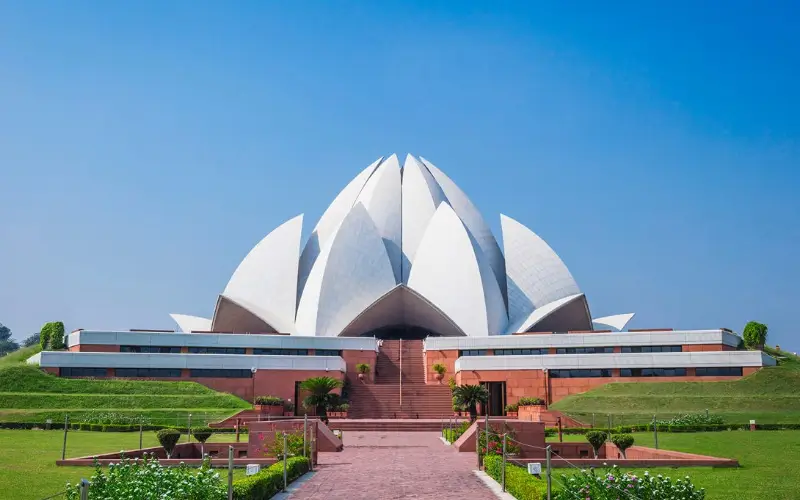
One of Delhi's most notable modern architectural marvels. Resembling a lotus flower in full bloom, this Baha'i House of Worship is a serene place for meditation and prayer, open to people of all faiths. Completed in 1986, its 27 petal-like structures are made of white marble and are surrounded by lush gardens and artificial ponds. The temple's unique design and peaceful ambiance make it a must-visit attraction for those looking to experience Delhi's blend of modernity and spirituality. Tourists can enter the large central hall of the temple and enjoy its serene atmosphere, which offers a break from the bustling city life.
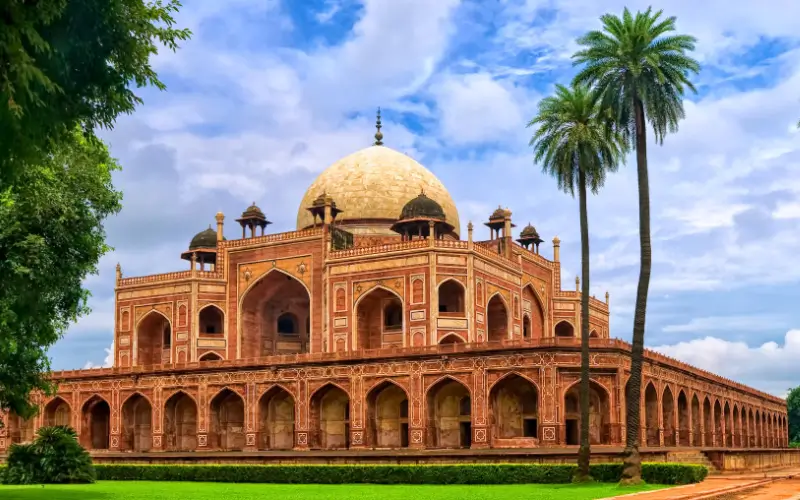
One of the most stunning examples of Mughal architecture in Delhi. Built in 1565 by Empress Bega Begum, wife of Emperor Humayun, this magnificent mausoleum is set in a beautiful, symmetrical garden, with pathways and water channels leading to the central tomb. The iconic dome of the tomb, surrounded by smaller structures and pavilions, is a fine example of Mughal garden tombs. Humayun's Tomb also houses the tombs of other Mughal emperors and royals, making it an important historical and cultural site. Tourists visiting the tomb can appreciate its intricate architecture, beautiful stone carvings and the peaceful gardens surrounding the monument.
If you are visiting Delhi in winter, you will love the cool climate, which makes sightseeing more comfortable. The best places to visit in Delhi during winter include Lodhi Gardens, Jama Masjid and the vibrant shopping area of Connaught Place.
No Delhi Agra Jaipur tour is complete without witnessing the beauty of the Taj Mahal in Agra. Agra, a city full of Mughal history, offers much more than just the Taj Mahal; it is a treasure trove of architectural marvels.
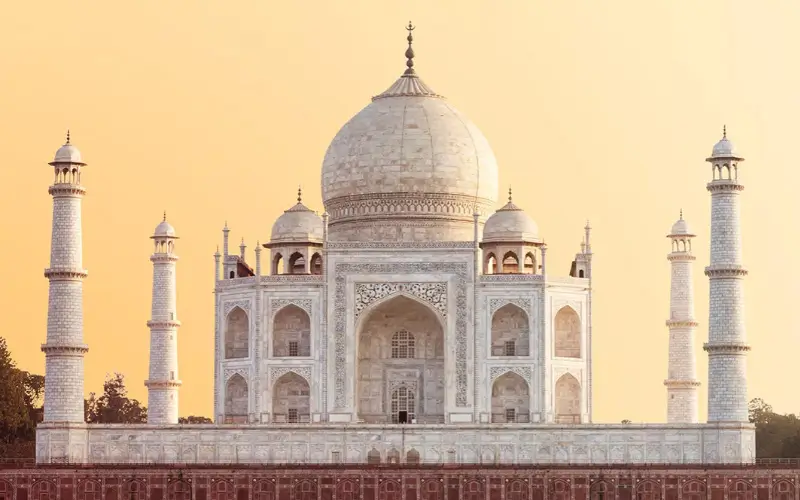
conic symbol of eternal love and one of the most visited monuments in the world. Built by Emperor Shah Jahan in memory of his beloved wife Mumtaz Mahal, this magnificent white marble mausoleum is located in Agra and is a UNESCO World Heritage Site. Its intricate craftsmanship, amazing symmetry and majestic domes make it a masterpiece of Mughal architecture. The Taj Mahal is also recognized as one of the New Seven Wonders of the World. The lush gardens, reflective ponds and beautiful surrounding landscape add to its charm. Tourists can admire the ornate carvings, precious stones embedded in the marble and the serene atmosphere, making it an unforgettable experience.
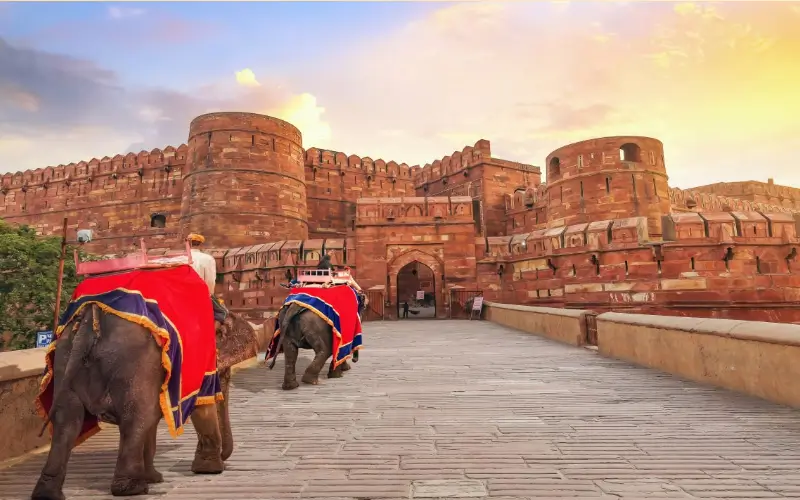
Located just a short distance from the Taj Mahal, the Agra Fort is another UNESCO World Heritage Site that showcases a glimpse of India's royal Mughal past. Built by Emperor Akbar in the 16th century, this magnificent fort served as the military base and royal residence of the Mughal Empire. The fort is made of red sandstone and houses impressive structures such as the Diwan-e-Aam (Hall for Public Audience), Diwan-e-Khas (Hall for Private Audience), Sheesh Mahal (Mirror Palace) and Jahangir Mahal. Tourists can also enjoy panoramic views of the Taj Mahal from certain points within the fort, creating a beautiful contrast between the two majestic landmarks.
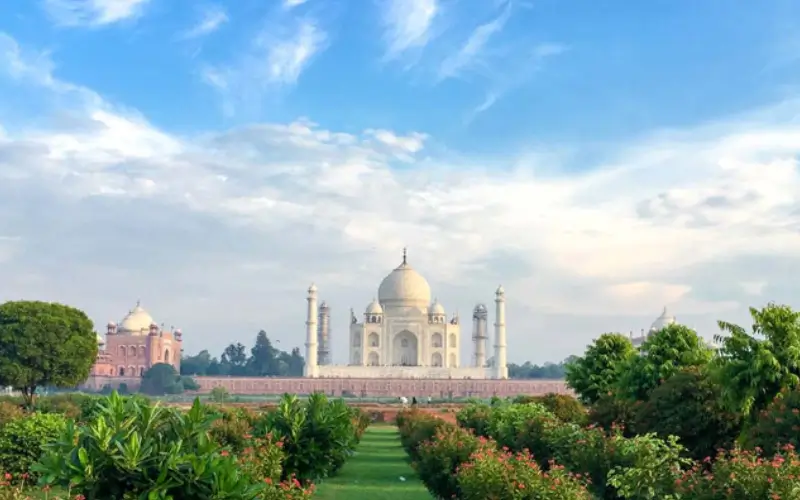
Also known as Moonlight Garden, is located across the Yamuna River near the Taj Mahal, providing one of the most serene and picturesque views of the monument. This beautiful garden was designed by Emperor Shah Jahan as a perfect spot for his queen to admire the Taj Mahal in the moonlight at night. The central location of the garden allows visitors to capture stunning photographs of the Taj Mahal reflected in the calm waters of the river. Mehtab Bagh offers a peaceful atmosphere away from the hustle and bustle, making it an ideal place for those who want to experience the grandeur of the Taj.
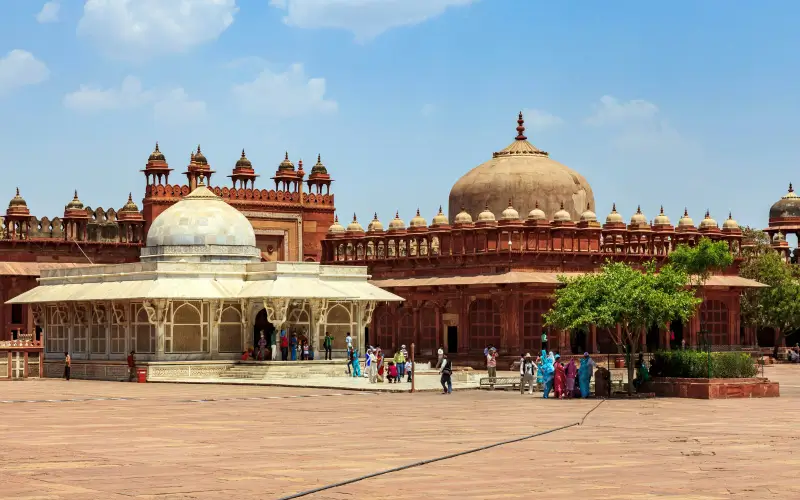
Located about an hour's drive from Agra, Fatehpur Sikri is an ancient city that was the capital of the Mughal Empire during the reign of Emperor Akbar. Built in the late 16th century, this UNESCO World Heritage Site is famous for its well-preserved palaces, mosques, and courtyards that reflect the grandeur of Mughal architecture. The city is home to the Buland Darwaza, one of the largest gateways in the world, and the Jama Masjid, a magnificent mosque with intricate carvings and designs. Tourists can visit the Panch Mahal, Diwan-e-Aam, Diwan-e-Khas, and the Tomb of Salim Chishti. Fatehpur Sikri was abandoned soon after Akbar's reign due to water shortage.
Visit Agra in December or Agra in winter to enjoy cooler temperatures and fewer crowds at the Taj Mahal. Sunrise over the Taj Mahal is a magical experience. Arrive early to see the monument bathed in the soft, golden light of dawn. The distance from Delhi to Agra is about 230 km, making it a comfortable road trip or train journey.
The capital of Rajasthan, Jaipur is often called the Pink City for its trademark pink coloured buildings. It is a city that is brimming with royal charm, with grand palaces, massive forts and colourful bazaars that will transport you back in time.
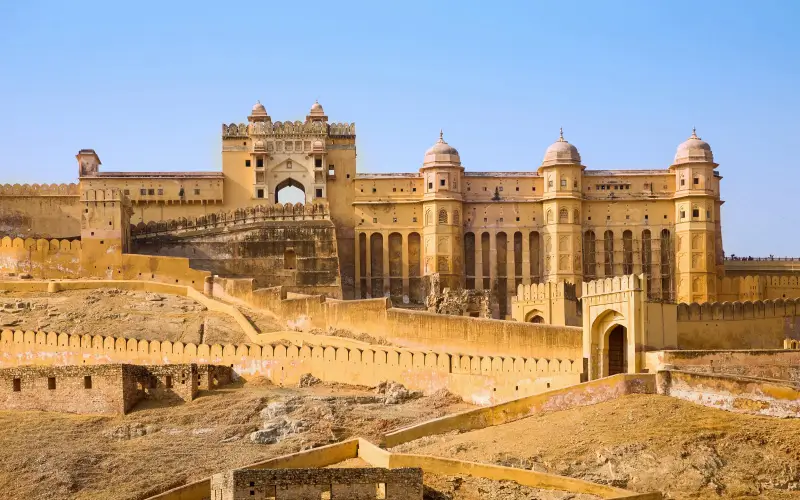
Majestic fort located on a hilltop overlooking the picturesque Maota Lake, just outside Jaipur. Built by Maharaja Man Singh I in the 16th century, the fort is an excellent example of Rajput military architecture. The fort's stunning sandstone and marble structures, intricate carvings, and massive gates make it one of the most popular tourist attractions in Rajasthan. Highlights of the Amer Fort include the grand Sheesh Mahal (Mirror Palace), the Diwan-i-Aam (Hall of Public Audience) and the Ganesh Pol, a gate adorned with beautiful artwork. Visitors can enjoy an elephant ride or jeep ride up to the fort entrance, which adds to the regal experience. The Amer Fort offers spectacular views of the surrounding hills, gardens, and the lake, making it a must-visit destination in Jaipur.
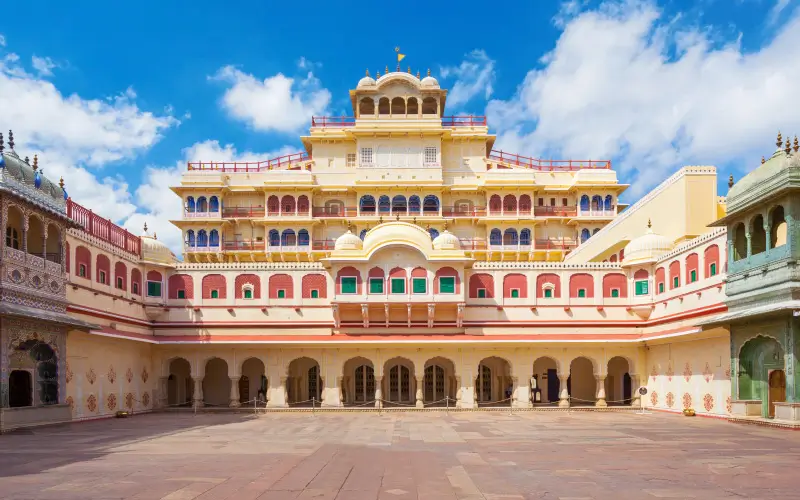
Located in the heart of Jaipur, the City Palace is a stunning architectural masterpiece that blends Mughal and Rajput styles. The palace complex is still the residence of the royal family and offers visitors a chance to glimpse the lifestyle of Rajasthan's erstwhile royals. The City Palace is a vast complex with several courtyards, gardens and museums, showcasing royal artifacts, textiles and paintings. The Chandra Mahal, the main palace, houses the royal family’s private quarters, while the Mubarak Mahal and Diwan-i-Khas (Hall of Private Audience) display incredible Mughal-style architecture. The combination of intricately carved doors, ornate frescoes, and courtyards creates a beautiful fusion of Mughal grandeur and Rajput elegance. The City Palace is a living testament to Jaipur's royal heritage and is a must-see for anyone visiting the city.
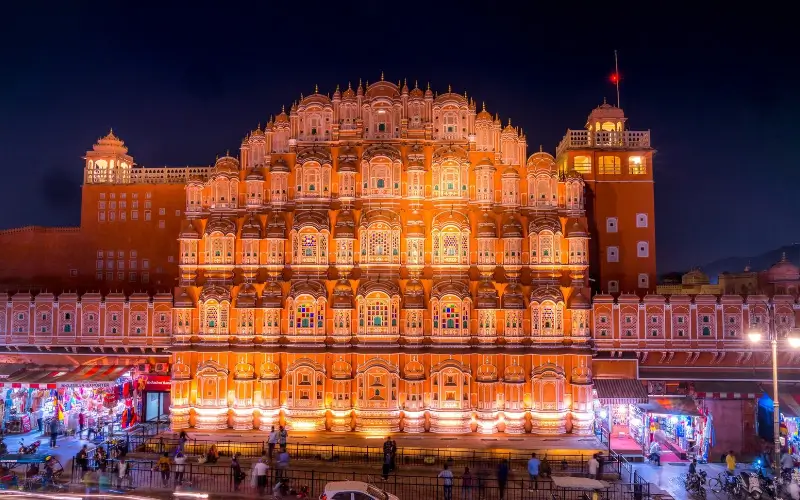
Also known as the Palace of Winds, is one of Jaipur’s most iconic landmarks. This five-story palace, built by Maharaja Sawai Pratap Singh in 1799, is a unique structure with over 900 windows (or jharokhas) designed to allow the royal ladies to observe street processions and festivals without being seen by the public. The palace’s striking honeycomb structure, made from pink sandstone, is a stunning example of Rajput architecture. The intricate lattice work and the beautiful archways allow for cool air to flow through, providing a natural air-conditioning system. Visitors can admire the palace from the street level, or explore the small museum and the rooftop for a fantastic panoramic view of the city.
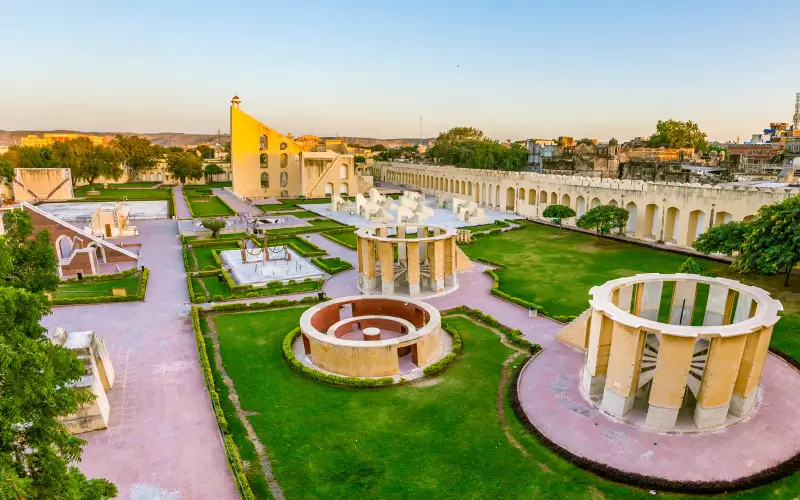
An extraordinary astronomical observatory and a UNESCO World Heritage Site. Built by Maharaja Jai Singh II in the 18th century, it is a collection of 19 architectural astronomical instruments, some of which are still operational. The observatory includes massive structures such as the Samrat Yantra, the world’s largest stone sundial, and the Jai Prakash Yantra, used to measure the altitude and azimuth of celestial bodies. The instruments are remarkably accurate and showcase the advanced scientific understanding of the time. Visitors to Jantar Mantar can explore these ancient instruments and learn about the science of astronomy that was practiced centuries ago, making it an essential stop for anyone interested in history, science, and architecture.
Visit Jaipur in winters or in December to avoid the scorching heat of summer. The cool weather is perfect for exploring the Pink City. Jaipur in November is also a great option for a quieter trip. Don't miss shopping at the bustling Johri Bazaar and Bapu Bazaar.
Generally speaking, the number of guests varies according on the place. World tours often have 40–47 people in the group, while Indian tours typically have 28–56 people. However, the group size may exceed the previously mentioned group size if a specific tour receives a large number of reservations or if it is a unique tour.
Delhi Agra Jaipur tour for 7 days itinerary
Day 1: Delhi Arrival
Day 2: Delhi Sightseeing
Day 3: Agra Transfer
Day 4: Fatehpur Sikri and the Taj Mahal visit
Day 5: Jaipur Transfer
Day 6: Jaipur Sightseeing
Day 7: Departure from Jaipur
Golden Triangle is most accessible during the winter months of October through February, when average temperatures range from 22 to 32°C. Both Delhi and Jaipur experience frigid temperatures in December and January. Thar's sands chill to freezing temperatures but also heat up readily.
The 4-day Golden Triangle Tour is a fun, quick way to see Delhi, Jaipur and Agra. Get the opportunity to go to three distinct Indian states. Due to its excellent accessibility, the majority of travelers prefer to begin their three-night, four-day Golden Triangle Tour in Delhi.
Delhi is 200 kilometers away from Agra and Jaipur is 265 kilometers away. You can take a private trip to Delhi, Agra and Jaipur with this current tour package.
Book Our Best Tours of Golden Triangle Tours In India
We are delighted that you reached here.
Please share your queries with us regarding the booking tour with us.
Call us at +91-9314165249 Email at info@goldentriangletoursinindia.com